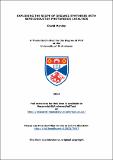Files in this item
Exploring the scope of organic syntheses with semiconductor photoredox catalysis
Item metadata
| dc.contributor.advisor | Walton, John C. | |
| dc.contributor.author | Manley, David | |
| dc.coverage.spatial | 242 | en_US |
| dc.date.accessioned | 2015-07-28T12:08:02Z | |
| dc.date.available | 2015-07-28T12:08:02Z | |
| dc.date.issued | 2014 | |
| dc.identifier | uk.bl.ethos.658920 | |
| dc.identifier.uri | https://hdl.handle.net/10023/7047 | |
| dc.description.abstract | Under dry, anaerobic conditions TiO₂ photoredox catalysis has been directed away from oxidative/degradative chemistry. Instead, carboxylic acid photoredox reactions resulted in carbon-carbon bond forming processes. High yields of radical homodimers were obtained from TiO₂ treatment of carboxylic acids alone. “Benzyl-type” radicals in particular performed very well in this system. Attempts at carrying out hetero-dimerisations were unsuccessful as it is thought that the differing rates of formation of radicals at the titania surface precludes the formation of cross-coupled products. A straightforward reaction mechanism involving hole- capture by the carboxylate at the catalyst surface has been put forward and is supported by literature precedent. Intramolecular dimerisations of di-carboxylic acids have been applied to the preparation of macrocycles but with disappointing yields being recorded. Photoredox reactions employing TiO₂ and carboxylic acids, under dry anaerobic conditions, led to several types of C-C bond forming processes with electron deficient alkenes. The efficiency of alkylation varied appreciably with substituents in the carboxylic acids. The reactions of aryloxyacetic acids with maleimides resulted in a cascade process in which a pyrrolo-chromene derivative accompanied the alkylated succinimide. Selectivity for one or other of these products could be tuned to some extent by employing the photoredox catalyst in different conditions. An array of different catalyst forms was trialed for efficiency and ease of use. The proposed mechanism, involving hole capture at the TiO₂ surface by the carboxylates followed by CO₂ loss, was supported by EPR spectroscopic evidence of the intermediates. Deuterium labelling indicated the titania likely donates protons from surface hydroxyl groups as well as supplying electrons and holes thus acting as both a catalyst and a reaction partner. Suitably functionalised carboxylic acids undergo a previously unknown photoredox reaction when irradiated with UVA in the presence of maleimide. Maleimide was found to synergistically act as a radical generating photoxidant and as a radical acceptor, negating the need for a photoredox catalyst. Modest to excellent yields of the product chromenopyrroledione, thiochromenopyrroledione and pyrroloquinolinedione derivatives were obtained in thirteen preparative photolyses. In-situ NMR spectroscopy was used to study each reaction. Reactant decay and product build-up were monitored, enabling reaction profiles to be plotted. A plausible mechanism, whereby photo-excited maleimide acts as an oxidant to generate a radical ion pair, has been postulated and is supported by UV-vis. spectroscopy and DFT computations. The radical-cation reactive intermediates were also characterised in solution by EPR spectroscopy. | en_US |
| dc.language.iso | en | en_US |
| dc.publisher | University of St Andrews | |
| dc.subject.lcc | QD262.M27 | |
| dc.subject.lcsh | Organic compounds--Synthesis | en_US |
| dc.subject.lcsh | Photocatalysis | en_US |
| dc.title | Exploring the scope of organic syntheses with semiconductor photoredox catalysis | en_US |
| dc.type | Thesis | en_US |
| dc.type.qualificationlevel | Doctoral | en_US |
| dc.type.qualificationname | PhD Doctor of Philosophy | en_US |
| dc.publisher.institution | The University of St Andrews | en_US |
This item appears in the following Collection(s)
Items in the St Andrews Research Repository are protected by copyright, with all rights reserved, unless otherwise indicated.

